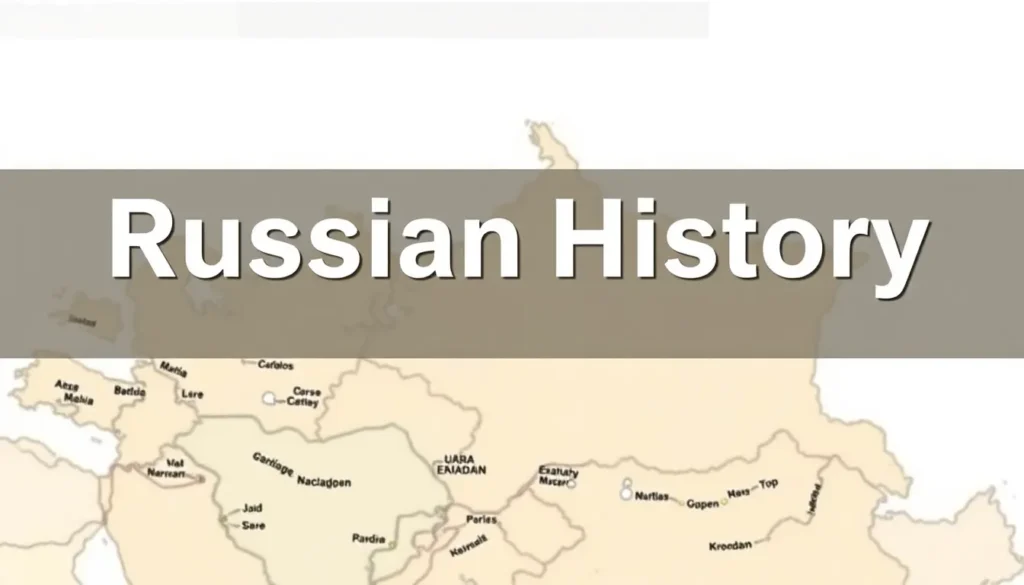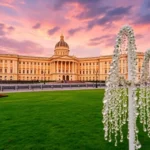Brief Overview of Russian History

When you think of Russia, vivid images may flash through your mind: the grandeur of the Tsars' palaces, the grim uniforms of the KGB, the tumult of the Bolshevik Revolution, or perhaps the tensions of the Cold War. The history of Russia is not only long and complex but also immensely fascinating. If you're planning to travel to this vast country, understanding the significant moments in its past can provide valuable insight into its current culture, people, and mindset. So, sit back and let's take a journey through time to explore the intricate tapestry of Russia's history.
This overview has been segmented into three main parts for easier navigation:
- History of Russia from its beginnings to 1900
- History of Russia from 1900 to the fall of the USSR
- History of Russia from the fall of the USSR to the present day
History of Russia from its beginnings to 1900
The origins of what we now know as Russia can be traced back to a combination of various tribes and cultures. Understanding these early centuries sheds light on the foundations of the Russian state.
The Birth of the “Country” and the Era of Kievan Rus
Russia's expansive territory has been home to numerous ethnic groups throughout its history, but two groups, the Slavs and the Varangians (Vikings from Scandinavia), played crucial roles in the formation of a united nation. By the 9th century, these tribes began to coalesce.
One of the pivotal moments in Russian history occurred in 882 when Oleg the Wise, a Varangian prince, unified the northern (Novgorod) and southern (Kiev) territories, marking the establishment of "Kievan Rus" and making Kiev its capital. This era saw significant cultural and economic growth, largely due to the establishment of trade routes connecting the Baltic Sea to the Black Sea, enhancing commerce and cultural exchange.
However, this golden age was short-lived. The subsequent centuries were fraught with political fragmentation and cultural decline, as Kievan Rus fractured into various principalities, many of which succumbed to invasions by Mongols and Teutons. A key figure from this period is Alexander Nevsky, a prince celebrated for his diplomatic acumen and military prowess against foreign invaders, gaining reverence in Russian history.
The Orthodox Faith: A Cultural Cornerstone
Another essential aspect of Russian culture is the Orthodox Christian faith. Initially, Kievan Rus adhered to Roman Catholicism, but in 988, Prince Vladimir converted to Byzantine Christianity, laying the foundation for the Russian Orthodox Church. This shift had profound implications for Russian identity and culture.
Some key differences between Orthodox and Catholic beliefs include:
- Orthodox Christians do not recognize a single pope; leadership is decentralized with various patriarchs.
- They reject the concept of the Immaculate Conception of the Virgin Mary.
- Orthodox beliefs do not include purgatory, though they affirm heaven, hell, and a final judgment.
- Orthodox practices permit divorce, unlike Catholics who view it as forbidden.
- The Orthodox baptism involves full immersion, contrasting with the traditional Catholic practice.
- Orthodox churches utilize icons rather than statues, emphasizing a different approach to venerating saints.
The Principality of Moscow and the Rise of the Tsardom under Ivan the Terrible
Entering the 14th century, the Principality of Moscow began to rise in power, ultimately leading to the establishment of Tsardom with Ivan IV (1530-1584), known as Ivan the Terrible. His reign marked significant territorial expansion, legislative reforms, and the establishment of Russia as a formidable power.
However, Ivan was notorious for his violent temperament, culminating in the tragic death of his own heir during a fit of rage, leading to a chaotic succession crisis.
The Time of Troubles
The death of Ivan IV left Russia in disarray, plunging the nation into the Time of Troubles, a period marked by famine, civil strife, and the rise of false leaders claiming the throne. This turmoil ended in 1610 when the nobility elected Mikhail Romanov as the new monarch, establishing the Romanov dynasty that would rule until the early 20th century.
Peter the Great and Catherine the Great
In 1682, Peter I, known as Peter the Great, ascended to the throne. He recognized that Russia lagged behind Europe in many respects and sought to modernize the country by integrating Western culture and practices. His most notable achievement was the founding of Saint Petersburg, envisioned as a "window to the West."
Peter's military reforms were equally significant, culminating in victories over Sweden, granting Russia access to the Baltic Sea and European trade routes. Following his death in 1725, Catherine II, or Catherine the Great, further solidified Russia's status as a major global power, albeit amidst growing discontent among the peasantry, setting the stage for future revolutions.
The Invasion of Napoleon
One of Napoleon Bonaparte's most infamous failures was his attempt to invade Russia in 1812. Initially, his forces entered Moscow, but the harsh Russian winter and a scorched earth policy led to devastating losses for the French army. This catastrophic retreat marked a turning point in the Napoleonic Wars, showcasing the resilience of the Russian people.
After the war, Alexander II took the throne but met an untimely death due to an assassination, a pivotal moment that would influence future leaders, including Lenin.
History of Russia from 1900 to the fall of the USSR
The 20th century was a whirlwind of dramatic events for Russia, with rapid changes that would ultimately reshape the nation.
The End of Tsardom, the October Revolution, and Lenin's Rise
The reign of Nicholas II, the last Tsar, came to an end in 1917 during the February Revolution. The populace, weary of autocratic rule, was further embittered by Russia's involvement in World War I, leading to widespread discontent. Nicholas abdicated, and a provisional government took over.
However, the Bolshevik leader, Vladimir Lenin, returned from exile in Switzerland to capitalize on the unrest. With German support, he led the October Revolution, resulting in the establishment of a communist government and the start of a civil war between the Red Army and White Army.
The Lenin Era and the Birth of the Soviet Union
Following the revolution, the Bolsheviks executed the Romanov family in 1918 to eliminate any threats to their power. In 1922, the Soviet Union was officially founded, establishing a communist state that aimed to abolish capitalism and promote collective ownership.
Stalin's Ascendancy
Lenin's death in 1924 led to the rise of Joseph Stalin, whose regime became synonymous with brutality and repression. The Great Purge targeted perceived enemies, resulting in millions being imprisoned or executed, while the devastating Holodomor resulted in widespread famine, particularly in Ukraine.
Despite the oppressive atmosphere, the Soviet regime expanded education, healthcare, and industrialization efforts. However, the cost was high, with millions suffering under Stalin's reign.
World War II and Its Aftermath
Initially, Stalin signed a non-aggression pact with Hitler, which was broken by the German invasion of the USSR in 1941. The Soviet Union joined the Allied forces, playing a crucial role in defeating Nazi Germany. The immense sacrifice of the Soviet people during this conflict is often overshadowed by the contributions of Western allies.
The Cold War Era
Post-World War II, the Cold War began, pitting the Soviet Union against the United States in an ideological and geopolitical struggle. This period was marked by an arms race, proxy wars, and significant events like the Cuban Missile Crisis. The KGB was established during this time to maintain state security and suppress dissent.
History of Russia from the fall of the USSR to the present day
With the dissolution of the Soviet Union on December 26, 1991, a new chapter in Russian history began, characterized by both hope and turmoil.
The Russian Federation: Yeltsin, Putin, Medvedev, and Putin Again
The first president of the newly formed Russian Federation was Boris Yeltsin, who sought to transition the country from a state-controlled economy to a market-oriented one. However, this shift led to economic chaos, corruption scandals, and the rise of oligarchs, leaving many in poverty.
In 1999, Yeltsin resigned and appointed Vladimir Putin as his successor. Putin, a former KGB officer, took significant steps to consolidate power and stabilize the economy. His leadership has been controversial, with supporters praising economic growth and critics condemning authoritarian measures.
Putin's tenure has seen significant geopolitical events, including the annexation of Crimea in 2014, heightened tensions with the West, and ongoing conflicts in Syria and Ukraine. His complex legacy includes both advancements and setbacks for Russian society.
The rich tapestry of Russian history is marked by resilience and transformation. As you explore this vast country, you'll gain a deeper understanding of the events that have shaped its path, making your journey all the more meaningful.
| Save on your trip |
| Compare and find cheap flights here |
| Find accommodation at the best prices here |
| Book activities and excursions in Spanish here |
| 5% discount on your travel insurance IATI here |
| Book airport transfers here |
| Gift of €10 when booking transport across Europe here |
| Find out how to withdraw cash without commissions here |
| 5% discount on your eSIM from Holafly here |
| Rent a car with the best deals here |
| Compare prices for van rentals here |
| The best books and travel guides here |
| All our articles about Russia |



Deja una respuesta